Your Guide to the Captain Cook Snorkel Tour
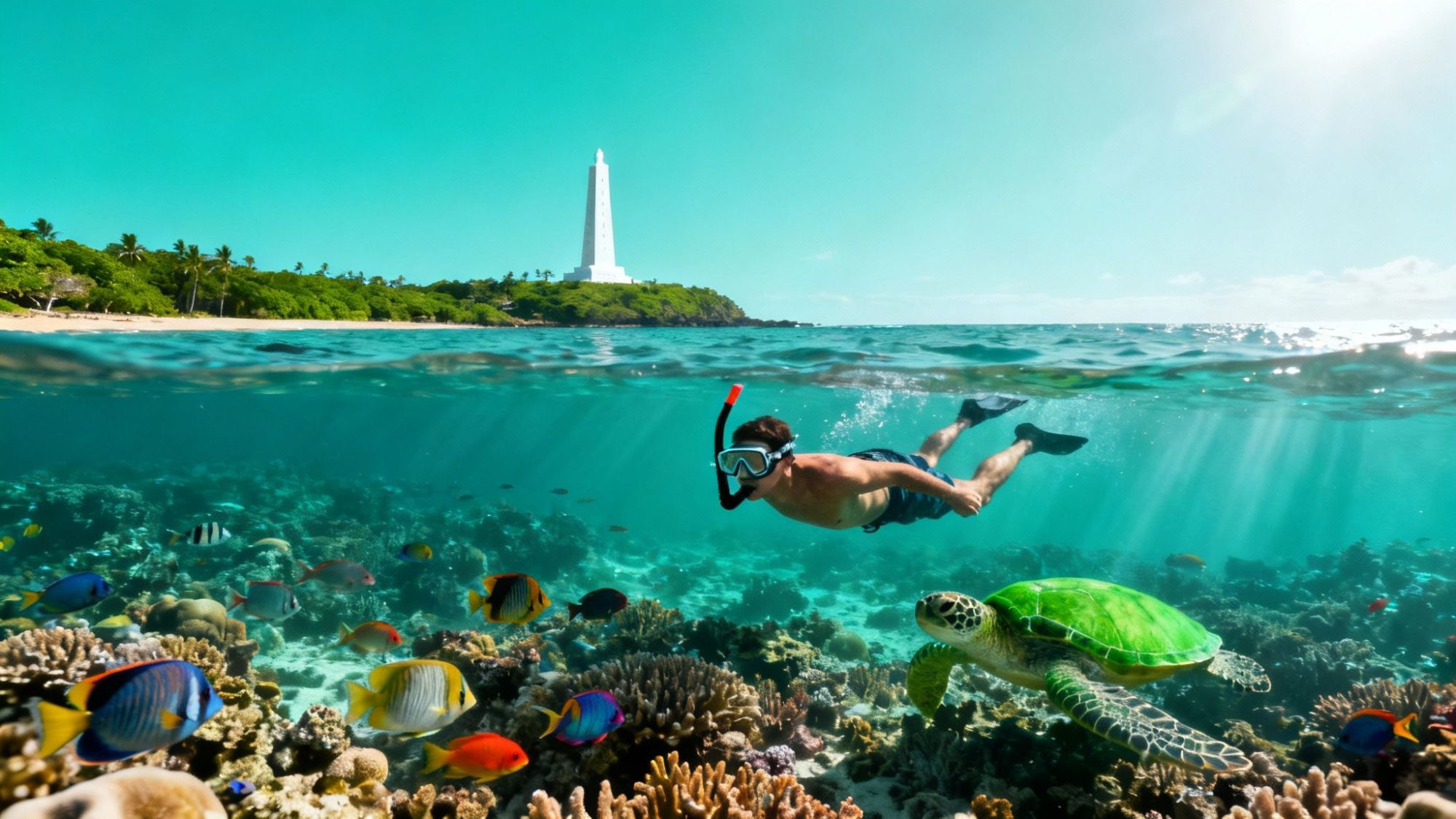
Picture this: you're gliding through impossibly clear, turquoise water. Swarms of colorful tropical fish dance around you, and vibrant coral gardens stretch out below. That’s the Captain Cook snorkel tour in a nutshell. It’s so much more than just another snorkeling trip; it’s a deep dive into Kealakekua Bay, a protected marine sanctuary brimming with life and layered with Hawaiian history. There's a good reason this adventure consistently tops the "must-do" lists for the Big Island.
Why This Snorkel Tour Is a Must-Do Adventure
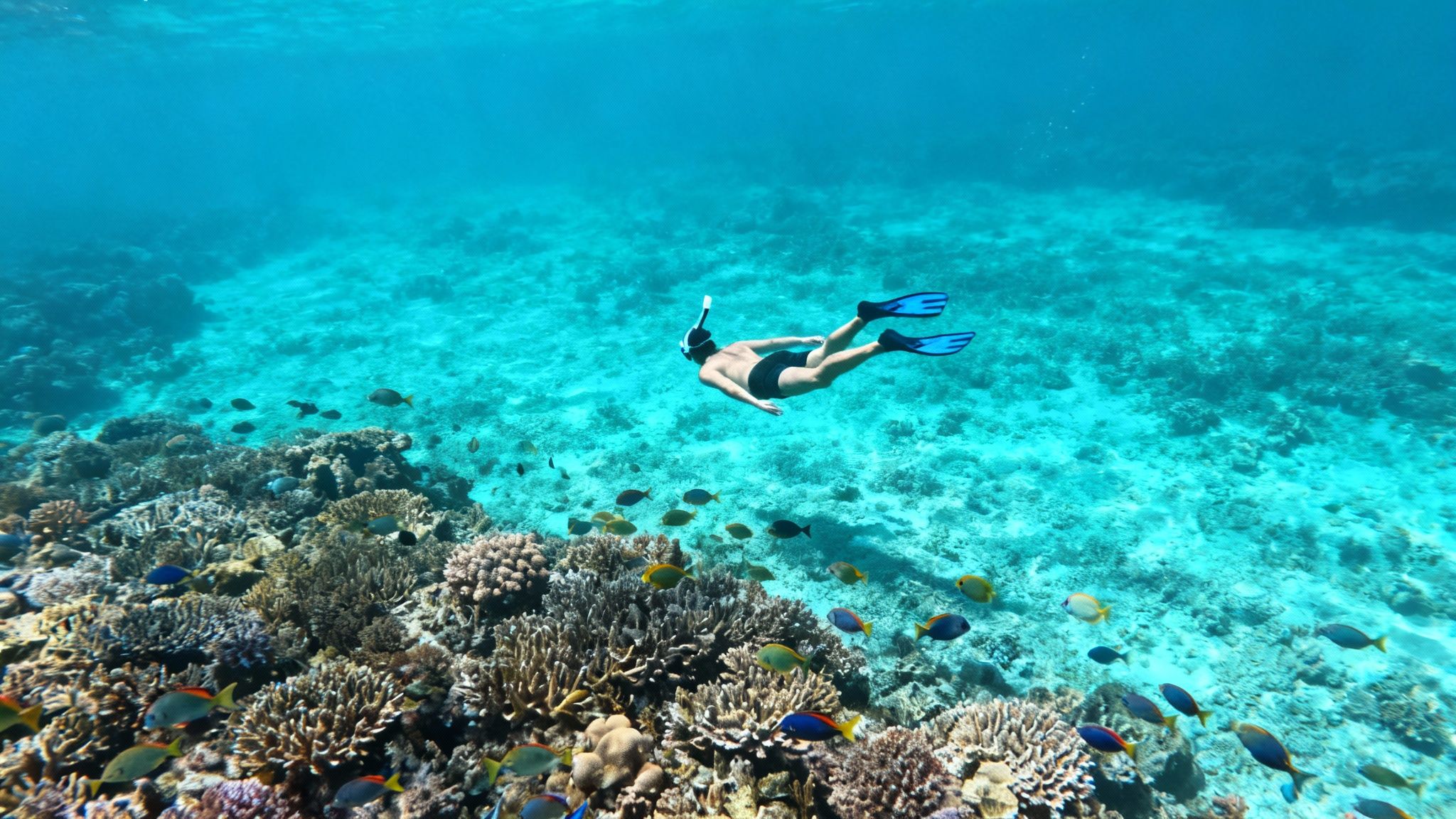
The magic of a Captain Cook snorkel tour is about more than just pretty fish. It's the unique combination of raw natural beauty, major historical significance, and pristine conditions that makes for a truly unforgettable day. Unlike so many coastal spots, Kealakekua Bay has been left largely untouched by shoreline development, which helps preserve its peaceful, wild vibe.
Let's break down the three key ingredients that make this tour so special: the incredible underwater world, the rich history of the bay, and the sheer beauty of this protected slice of paradise.
A Protected Underwater Paradise
The number one reason people flock here is, without a doubt, the marine life. Kealakekua Bay’s status as a Marine Life Conservation District means its underwater ecosystem is exceptionally healthy and thriving. You'll find the coral reefs are bursting with color, and the fish are plentiful and surprisingly unfazed by respectful snorkelers. This protected status is exactly why the bay is considered one of Hawaii’s absolute best snorkeling destinations.
Kealakekua Bay is a 315-acre marine sanctuary that’s home to dazzling coral reefs and a mind-blowing variety of sea life, including over 175 species of fish. This incredible biodiversity is a huge part of what makes the bay so famous.
Here’s a quick look at what you can expect on the tour.
Captain Cook Snorkel Tour Highlights
A quick look at the key features that define the Captain Cook snorkel tour experience.
| Feature | What to Expect |
|---|---|
| Marine Life | Healthy coral reefs, massive schools of fish, and frequent sightings of spinner dolphins. |
| Water Clarity | Exceptionally clear water, often with over 100 feet of visibility. |
| Historical Site | Snorkel right next to the iconic Captain Cook Monument, marking a significant point in Hawaiian history. |
| Accessibility | The best snorkeling spots in the bay are most easily reached by boat tour. |
| Protection | As a marine sanctuary, the area is pristine and teeming with life you won't see elsewhere. |
It's this combination of features that really sets the experience apart.
A Journey Through History
Beyond the reef, the tour is a trip back in time. This is the exact spot where Captain James Cook first landed in Hawaii in 1779, a moment that changed the islands forever. The iconic white obelisk you'll see on the shoreline is the Captain Cook Monument, a landmark commemorating this historic event. A great tour doesn't just show you cool stuff; it tells you the story behind it.
Putting it all together—the thriving reef, the calm waters, and the deep history—is what transforms this from just another activity into a truly meaningful experience. It’s no surprise it draws over 190,000 visitors every year, cementing its place as a cornerstone of any Big Island adventure. You can get even more details about this top-rated snorkel trip over at Kona Honu Divers.
Discovering the History of Kealakekua Bay
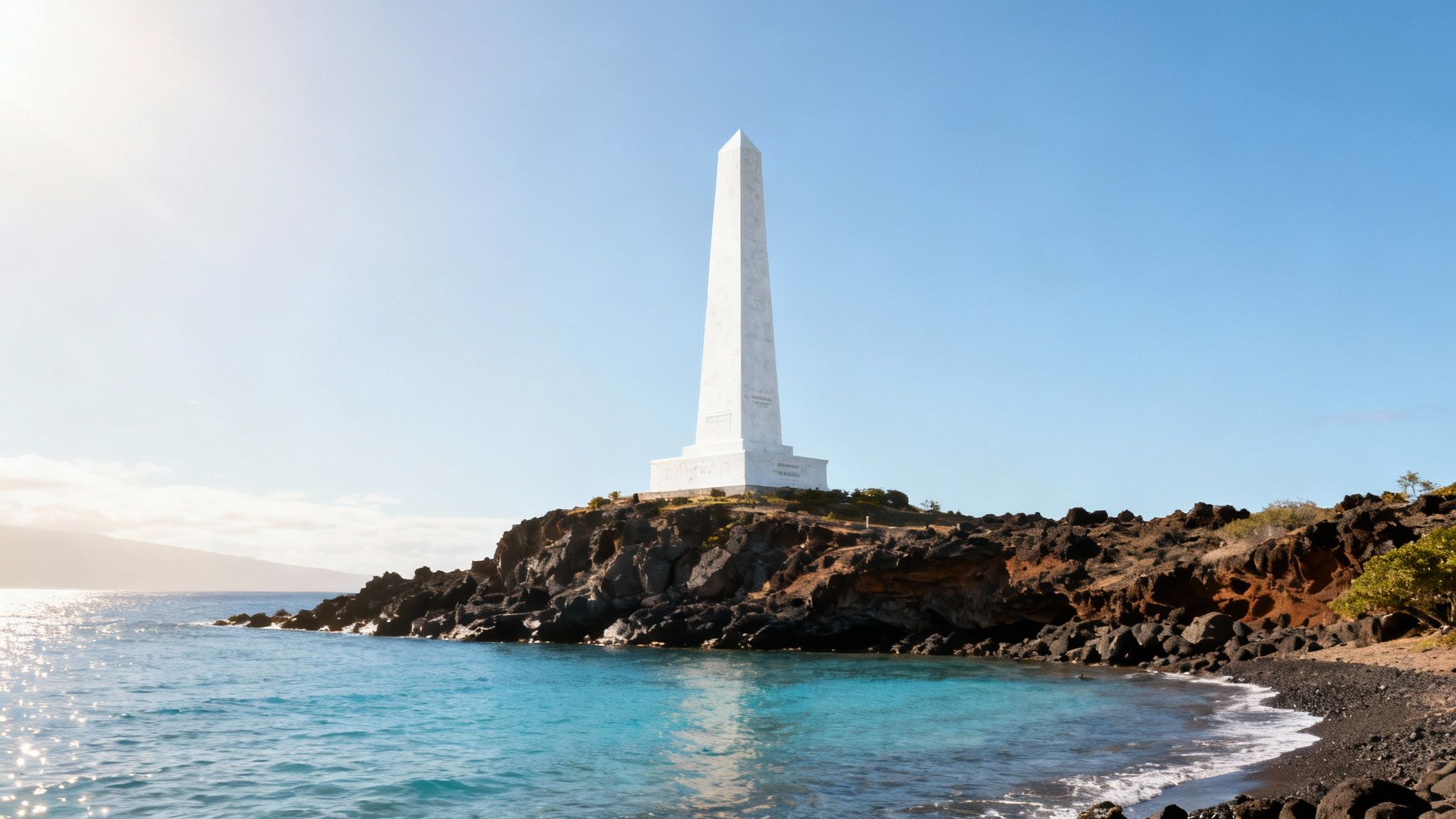
Before your fins even hit the water, it helps to know you’re about to snorkel in a place that’s basically a living museum. A captain cook snorkel tour isn't just about the fish; it’s a trip back in time. The calm, beautiful water you see today masks a dramatic and pivotal moment in Hawaiian history.
The story really gets going in 1779 when the British explorer, Captain James Cook, sailed into the bay. Long before his ships appeared, Kealakekua Bay was a sacred and powerful place for Native Hawaiians. Cook's arrival was the first real, prolonged contact between Hawaiians and the Western world, an event that changed the islands forever.
At first, things were peaceful. But as with many first encounters, cultural misunderstandings began to stack up. Tensions simmered and eventually boiled over, leading to a tragic fight that ended with Captain Cook's death right here in the bay. That somber event is what put Kealakekua on maps around the world.
The Iconic White Monument
As your boat pulls into the bay, you can’t miss it: a stark white obelisk standing against the lush green cliffs. That’s the Captain Cook Monument, and it’s more than just a landmark—it’s a constant reminder of the bay’s complex story.
The monument, put up in 1874, pinpoints where the famous explorer died. It adds a powerful layer to your snorkel trip, reminding you that this was a deeply sacred Hawaiian place long before Cook ever saw it.
Any good guide on a captain cook snorkel tour will share the stories, giving context to what you’re seeing. They help you connect the dots between the past and the present, which makes the whole experience much more meaningful.
A Deeper Connection to the Bay
Knowing this history completely changes how you see your surroundings. While you're floating over the incredible coral gardens, you’re also gliding over a site of huge cultural weight. Every time you look back at the shore and see that white monument, it clicks.
You start to understand why a Kealakekua Bay snorkeling tour is so much more than the average snorkel spot. It’s this incredible blend of stunning nature and a powerful story that makes the day unforgettable, connecting you directly to Hawaii’s past.
What Marine Life You Can Expect to See
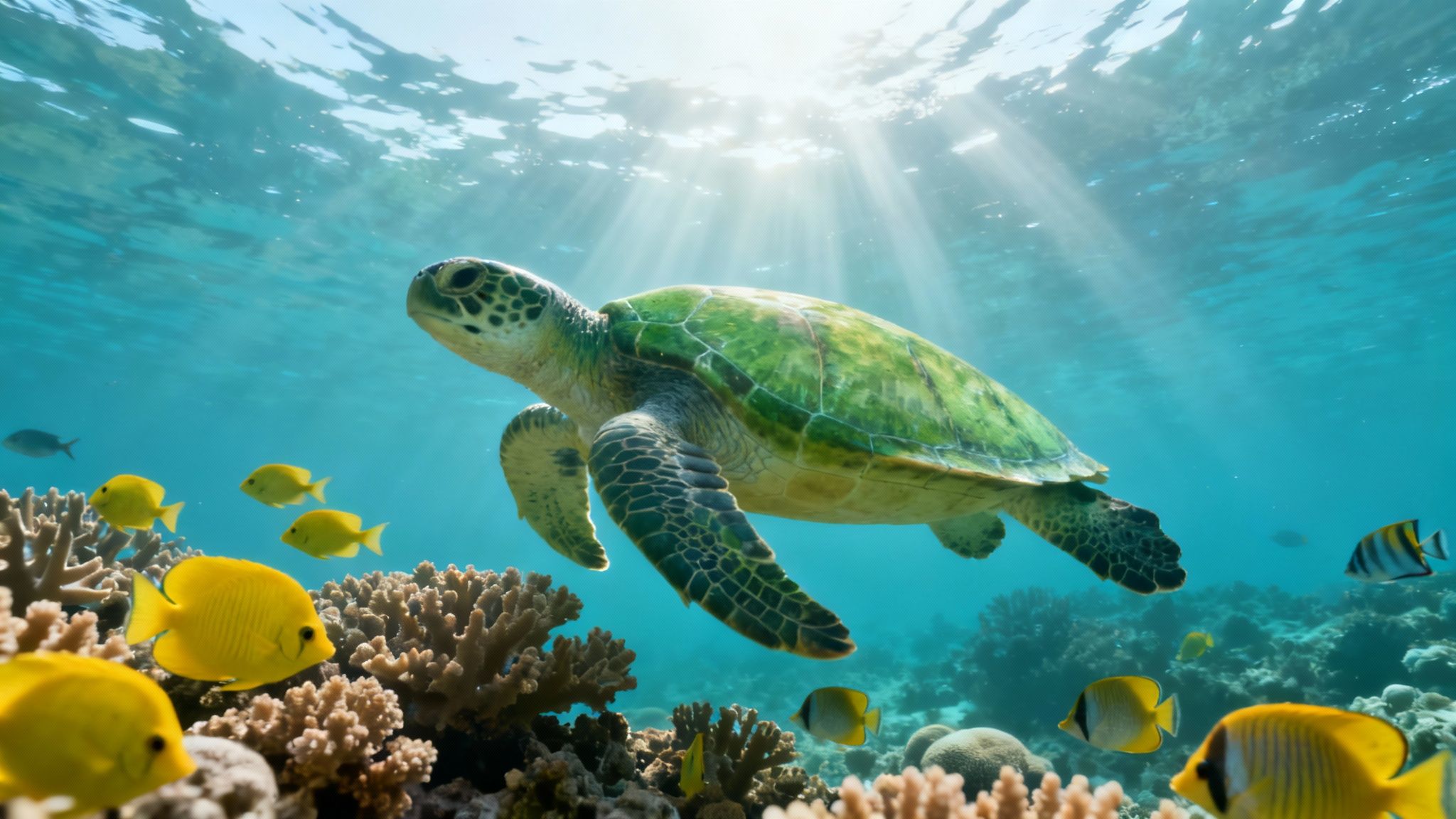
This is the part of your captain cook snorkel tour where things get real. It’s the moment you slip into the water and your snorkel trip transforms into a living, breathing nature documentary. Dropping into the calm, protected waters of Kealakekua Bay is like entering another dimension, one that’s absolutely buzzing with color and activity.
The bay is a Marine Life Conservation District for a reason. Its ecosystem is bursting with life, and the variety of species you’ll see is just stunning. On a good day, the water clarity can be incredible, sometimes letting you see over 100 feet in any direction. You're not just looking at a few fish; you're peering into a vibrant underwater city built upon intricate coral gardens, where every creature has its role.
One of the first things that'll hit you is the sheer number of fish. We're talking massive schools of brilliant yellow tang moving as one, creating a golden river that flows against the deep blue water. It's a mesmerizing sight, and they’re just the beginning of the kaleidoscope of life here.
The Stars of the Show
While the schools of fish are incredible, a few of the bay's residents are true headliners. Keep your eyes peeled for these iconic Hawaiian animals—spotting them is a frequent and always unforgettable experience.
- Hawaiian Spinner Dolphins (Naiʻa): The bay is a favorite resting spot for these acrobatic and playful dolphins. It’s pretty common to see a pod from the boat, leaping and spinning in the distance as they cruise through the area.
- Hawaiian Green Sea Turtles (Honu): For many of our guests, seeing a majestic honu glide gracefully through the water is the highlight of the day. You can often find these gentle, ancient reptiles munching on algae along the reef.
- Colorful Reef Fish: The variety is just mind-blowing. You’ll see everything from the striking raccoon butterflyfish with its bandit-like black "mask" to the elegant moorish idol. The reef is like a gallery of living art.
The fish here are different. Because this is a protected sanctuary, they're used to respectful snorkelers and often show a real curiosity. This can lead to some uniquely close and personal encounters that you just don't get in less protected waters.
Identifying What You See
With so much going on around you, it's a lot more fun when you know who's who. Putting a name to a face (or a fin!) turns your snorkel from simple observation into a rewarding underwater treasure hunt.
Want a head start? Check out our comprehensive Hawaiian fish identification guide and become an expert before you even get your feet wet. Knowing what you're looking at will make your captain cook snorkel tour that much more memorable as you connect with the beautiful creatures swimming right by you.
How to Choose the Right Snorkel Tour for You
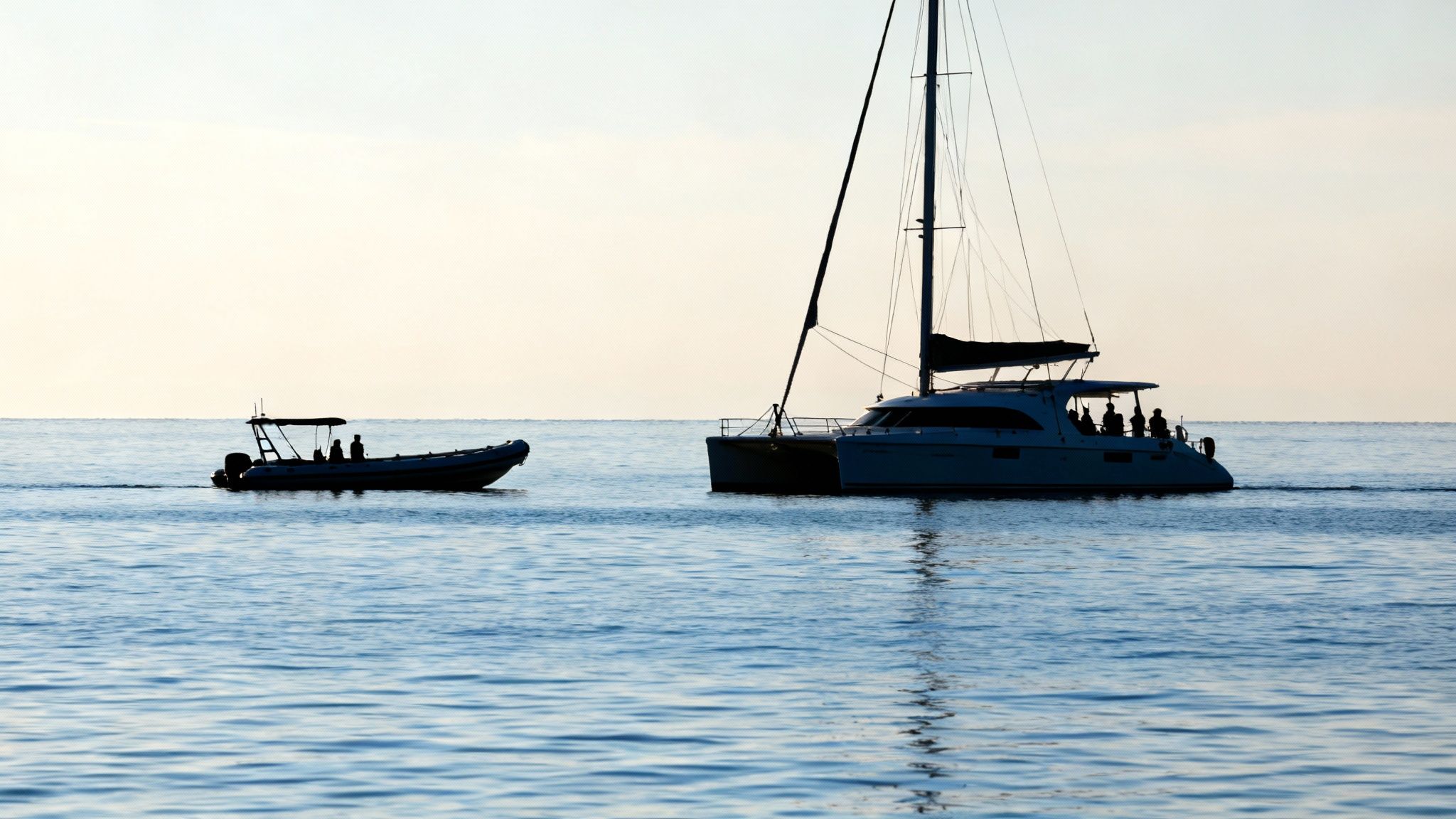
With so many companies offering a Captain Cook snorkel tour, picking the right one can feel a little overwhelming. But don't worry—the secret is just to match the tour with the kind of day you want to have. Your choice really shapes the whole experience, so it pays to know the key differences upfront.
It all boils down to a few things: the boat, the group size, and what's included. Get clear on what your crew needs, and you'll find the perfect trip, making your day at Kealakekua Bay one for the books.
Big Boat Comfort or Small Raft Adventure
The biggest choice you'll make is the boat itself. Think of it like deciding between a floating resort and a zippy speedboat. Each gives you a completely different vibe for your snorkeling adventure.
Large catamarans are the kings of comfort out on the water. They are incredibly stable, which is a huge relief for anyone who gets a little seasick. Plus, they come loaded with creature comforts that make the day smooth and relaxing.
- Onboard Restrooms: A total game-changer on longer trips, especially with kids.
- Plenty of Shade: Gives you a break from that strong Hawaiian sun.
- Food and Drinks: Many tours serve up a full lunch, which means less for you to pack.
- Easy Water Entry: Most have stairs or even slides, making it simple and fun to hop into the ocean.
On the flip side, you've got the smaller, rigid-hulled inflatable boats—often called rafts or zodiacs. These offer a more intimate, up-close-and-personal kind of ride. You're lower to the water, right in the middle of the action, which feels a lot more connected to the ocean.
A small raft tour often means a faster, more thrilling ride along the coast. These boats can duck into sea caves and check out little coves that the bigger vessels can't get to, adding a whole other layer of exploration to your Captain Cook snorkel tour.
Comparing Your Tour Options
To help you decide, we've broken down the key differences between the two main boat styles. Finding the best fit for your adventure is all about knowing what you want out of your day on the water.
Comparing Tour Boat Styles
Find the best fit for your adventure by comparing the two main types of tour boats.
| Feature | Large Catamaran Tours | Small Group Raft Tours |
|---|---|---|
| Best For | Families, large groups, and anyone prioritizing comfort and amenities. | Adventurous couples, small groups, and experienced snorkelers. |
| Group Size | Typically 20-40+ passengers, creating a social and lively atmosphere. | Usually 6-12 passengers, offering a personalized and quiet experience. |
| Ride Style | Smooth and stable, minimizing the chance of seasickness. | Fast and exciting, offering a more adventurous, bumpy ride. |
| Amenities | Often includes lunch, restrooms, and shaded seating areas. | Typically provides basic gear, snacks, and drinks. |
At the end of the day, there’s no single "best" boat—just the one that’s best for you. Whether you’re a family with young kids or a couple of thrill-seekers, thinking about your group's needs and desired adventure level will point you to the perfect vessel for an unforgettable day in Kealakekua Bay.
Essential Tips for a Perfect Snorkel Trip
To make sure your captain cook snorkel tour is unforgettable for all the right reasons, a little bit of prep work can make a world of difference. Seriously, thinking ahead about a few small details can take a good day on the water and turn it into a truly epic one, leaving you free to just soak in the underwater magic.
It all starts before you even walk out the door. Sunscreen is non-negotiable under the Hawaiian sun, but the kind you grab is a big deal. Always go for reef-safe sunscreen. That means it’s free of chemicals like oxybenzone and octinoxate, which are known to be really harmful to the coral. It’s a tiny choice for you that has a massive positive impact on the very ecosystem you’re about to visit.
Another thing that can ruin a day is seasickness. If you're prone to feeling a bit queasy, think about taking an over-the-counter motion sickness medication about an hour before we head out. Staying hydrated and just keeping your eyes fixed on the horizon can also do wonders.
Getting Comfortable in the Water
For a lot of folks new to snorkeling, the biggest challenge is just feeling confident with the gear. Getting a good seal on your mask is absolutely crucial for a fun, leak-free experience. Before you even hop in, press the mask to your face (without using the strap) and breathe in gently through your nose. If it suctions on and stays put, you've got a perfect fit.
Once you’re in the water, just take a minute to get used to everything.
- Put your face down and practice taking slow, deep breaths through the snorkel tube.
- If a little water splashes in, a sharp, quick puff of air—like you're blowing out a birthday candle—will clear it right out.
- Relax and float. The less you fight the water, the more energy you'll have and the more you’ll get to see.
Nailing these basics will make you feel so much more at home in the water, ready to enjoy every second. For a more detailed breakdown, check out our guide on snorkeling safety tips, which covers all the bases for a safe and awesome adventure.
Golden Rules of Snorkeling
As you start exploring the reef, just keep a few simple but super important rules in mind. These aren't just about keeping you safe; they’re about protecting the fragile marine home of Kealakekua Bay.
- Listen to Your Crew: We're out here every day and know the local conditions inside and out. Our instructions are all about keeping everyone safe and having a great time.
- Never Touch Marine Life: This goes for everything—coral, turtles (honu), and fish. Touching coral can damage or even kill it, and getting too close can stress out the animals and mess with their natural behavior.
- Be Aware of Your Surroundings: Always keep an eye on where the boat is, where other snorkelers are, and any potential currents. Just knowing your position is a key part of staying safe.
At the end of the day, it's all about being a respectful guest in an incredible underwater world. Following these simple habits makes sure it's a positive experience for you, the crew, and all the amazing sea life.
For an active trip like this, it's also smart to make sure you're covered. You might want to look into options for adventure sports travel insurance just to be safe. Keep these tips in mind, and you'll show up feeling prepared, confident, and ready to dive into the magic of your Captain Cook snorkel tour.
How to Snorkel Responsibly in a Marine Sanctuary
When you join a Captain Cook snorkel tour, you’re stepping into a place that’s far more special than your average beach. Kealakekua Bay isn’t just a pretty spot—it's a designated Marine Life Conservation District. The best way to think about it is less like a public park and more like a protected wildlife sanctuary, just underwater.
Because of this special status, the whole ecosystem is incredibly fragile. Every action you take, no matter how small, has a real impact on the health of the coral reefs and all the critters that call this bay home. Our goal, and yours, should be to leave this underwater paradise exactly as we found it, making sure it stays just as magical for everyone who comes after us.
It's all about being a respectful guest in their world. We call it "leave no trace," and it's easier than you think.
Your Role as a Steward
Being a good steward of the bay comes down to a few simple but really important habits. These aren't just rules; they're practices that protect the delicate balance of this sanctuary and make sure both you and the marine life have a good day.
- Keep a Respectful Distance: Always stay several feet away from the Hawaiian green sea turtles (we call them honu) and any other marine life. Getting right up in their space can stress them out and mess with their natural behaviors.
- Never Touch the Coral: It might look like a bunch of cool-looking rocks, but coral is actually a living animal. Just one touch can scrape off its protective slime layer, making it vulnerable to disease and even causing it to die. Look, but don't touch.
- Do Not Feed the Fish: Tossing food to the fish totally disrupts their natural diet. It can make them aggressive and dependent on people, which throws the whole ecosystem out of whack.
- Pack It In, Pack It Out: Make sure every single piece of trash—from snack wrappers to empty water bottles—comes back with you on the boat. Nothing gets left behind.
By following these simple guidelines, you stop being just a tourist and become an active partner in conservation. Your mindfulness helps preserve the very beauty you came all this way to see.
Of course! Here is the rewritten section, crafted to match the human-written style of the provided examples.
Got Questions? We've Got Answers
When you're planning an adventure like the Captain Cook snorkel tour, it's totally normal to have a few questions pop up. Knowing the little details beforehand means you can show up ready for an amazing day without any worries. We've heard just about every question in the book, so we’ve put the most common ones right here for you.
People always ask us, "When's the best time to go?" Honestly, you can't go wrong. Kealakekua Bay is incredible for snorkeling all year long. If you're looking for that picture-perfect, glassy-calm water and tons of sunshine, the summer months from April to October are your best bet. But, if you're visiting in the winter, say November through March, you get a massive bonus: the chance to see migrating humpback whales on the boat ride over!
Do I Need to Be a Pro Swimmer? What About the Monument?
We get this one a lot: "Do I need to be a strong swimmer?" Nope, not at all. Our boats are loaded with all the good stuff—life vests, pool noodles, you name it. These make it easy to just float on the surface and soak in the underwater scenery without a care in the world. As long as you're comfortable just being in the water, our crew is right there to make sure you have a safe and fantastic time.
Can you get to the Captain Cook Monument without a tour? You technically can, but it involves either a really tough hike or jumping through hoops to get a special kayak permit. The boat tour is, hands down, the easiest, safest, and most popular way to get there.
Going with a tour means you don't have to sweat the logistics. We handle everything, provide professional guides for your safety, and share all the cool history of the place you’d miss on your own. It just makes the whole experience of this beautiful, historic spot complete and totally stress-free.
Ready to see the magic of Kealakekua Bay for yourself? Kona Snorkel Trips delivers unforgettable snorkeling adventures that are safe, fun, and perfect for the whole family. Book your tour today and get ready to make some incredible memories.
